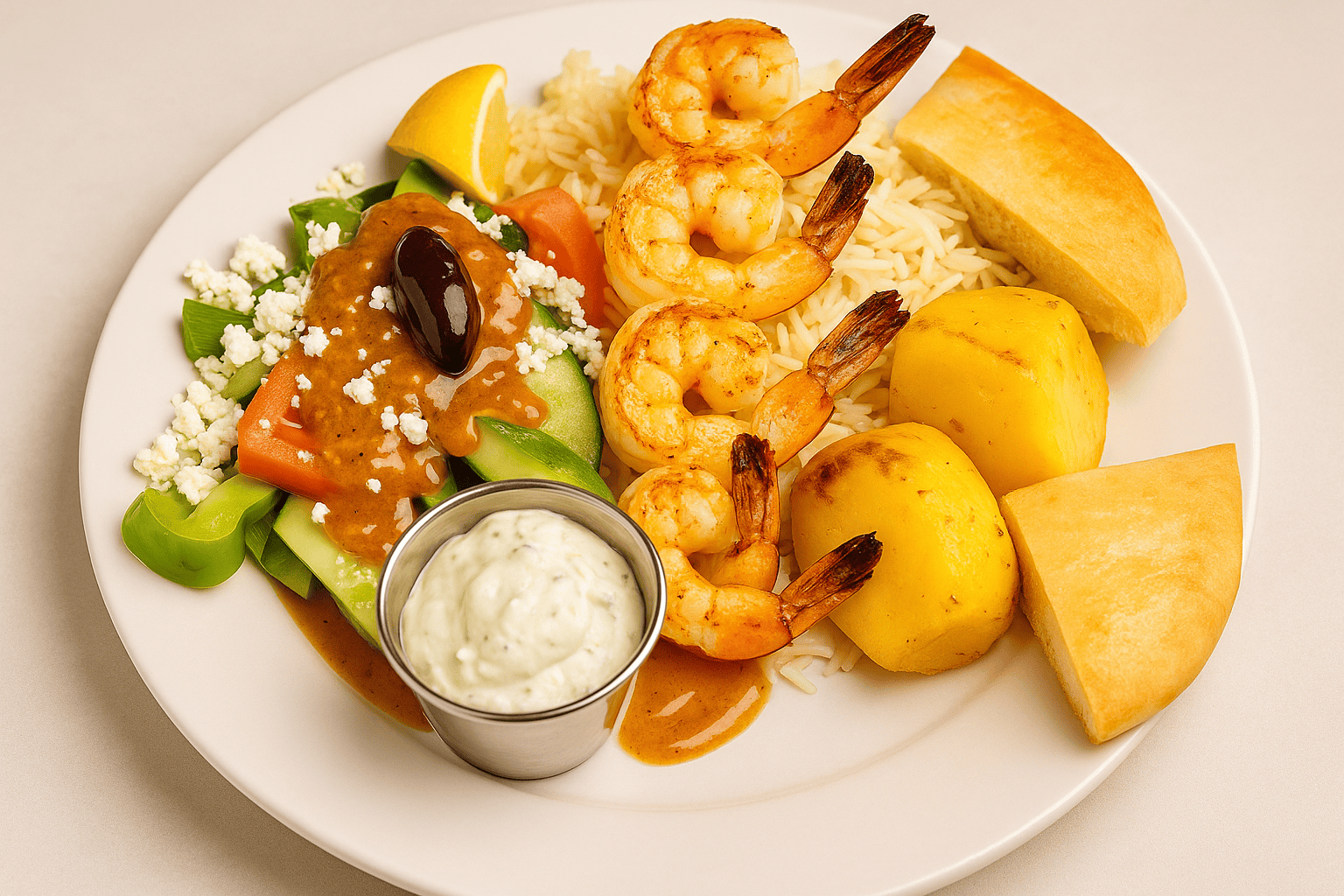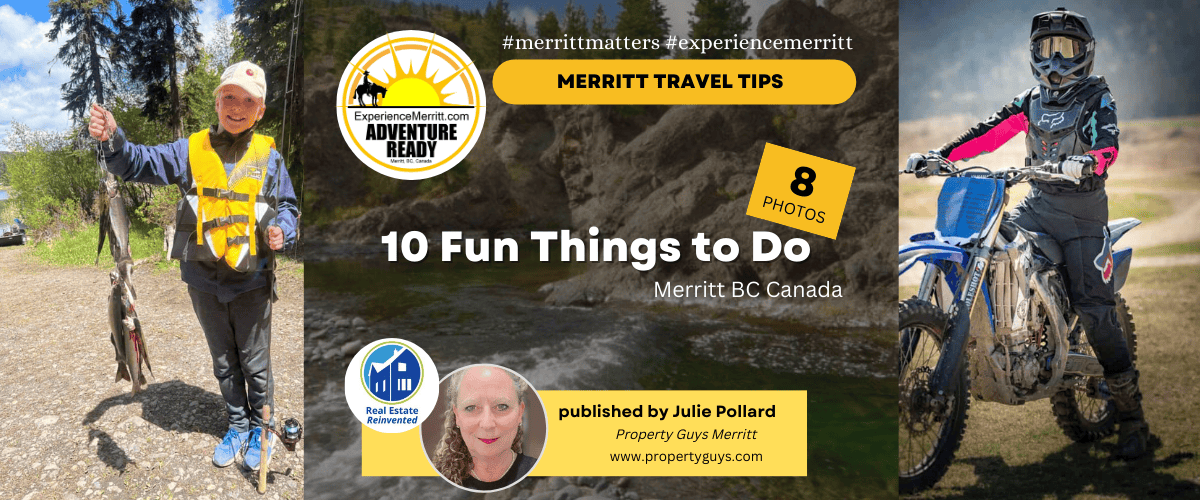Bikepacking Merritt – the Epic 1000
The BC Epic is a 1000km traverse across South Central BC
I rode as fast as I thought I could, without injuring or killing myself…
Darch Oborne participated in the BC Epic 1000, and tells us about the bikepacking adventure. In his words…
The BC Epic 1000 is an offroad, unofficial, completely self-supported bikepacking ride/race in the spirit

of the underground “Tour divide” style and under the same rules. No registration (other than on the website), no support, no insurance, no prizes – it is simply a plotted route with a suggested time for an unofficial group ride. Show up and ride at your own risk.
The BC Epic is a 1000km (1040 to be exact), 11,000m elevation traverse across South Central BC starting in Merrit and ending in Fernie (or vice versa if you choose) mostly along the Trans Canada Trail. The route is about 80% off road on mostly old decommissioned rail grades
The BC Epic 1000 bikepacking ride, since 2015
2018 was the third year of the bikepacking race, created by Dr. Lennard Pretorius of Kamloops. Jame Oborne and Lennard are also the first two riders to complete the Merritt 150 Epic on June 16, in eleven hours and forty-seven minutes. Lennard rode the first and second ‘1000’s’ and had a course record for a while. Virtually single-handedly, Lennard conceived and organized the Epic, seeing it grow from sixteen riders in 2016 to sixty-seven entrants in 2018. Quite an achievement! I predict there will be 100 racers in 2019.
I’d guess that of the sixty-seven riders entered, ten were extreme athletes, with three or four being extremely extreme, ie: 600 miles of off-road riding in less than three days, with less than six hours of sleep! Most of us “racers” chose to get at least some sleep (four to six hours in my case). nightly. Usually right at the side of the trail, after an evening meal at 9 PM, consisting of a couple of energy bars!
Many racers had lights and rode into the dark. My strategy was to ride as fast as I could without injury and to ride long, ie: from the crack of dawn at 4 AM to dark at 9 PM, to at least try to keep up with the middle of the pack.
The grades are less than three percent, but just relentless
The route is mostly old railway bed, including the KVR to Midway and Columbia Western to Castlegar. The grades are less than three percent, but just relentless, such as the climb out of Princeton to Summerland and Christina Lake to Castlegar–they just go on and on and on! But, through beautiful upland fields of flowers, several trestles, tunnels, raging rivers, beautiful forests, lovely meadows are all part of the Epic.
Many bikepacking racers stopped and took pictures of the beautiful features, often allowing me to catch up to them. Then there’s the torture of the Grey Creek Pass. Sixteen kilometers of ‘up’ on gravel, rutted road, at grades to sixteen percent–hike a bike for fifteen kilometers! No fun at all, after already being on the trail for four days.
It is self-supported, meaning you carry what you think you’ll need for each section ahead, including food and water. You can stop at towns or houses for provisions–root beers and double teenburgers–YUM! (I had some coupons from the mail).
I carried my small stove for a quick coffee
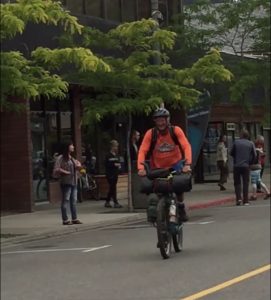
You carry what you think you’ll need to give you a good sleep, dry riding etc. I carried my small stove for a quick coffee/hot choc in the AM (I only used it twice), and I used a Kelty Thermarest pad, summer bag, and Tyvek covering, all wrapped up in my 1/2 body bag from Kiwanis Surplus store. The bikes of choice are Surly big boys, with 2.5″ to 2.8″ width tires.
I used my Transition Smuggler 29″ with gravel tires (2.5″ on the front and 2.3″ on the rear) until I broke the Hammerschmidt bottom bracket bolt about 3 miles N of Beaverdell at 6 AM on Day 3. Luckily, my son James was in Vernon and after a two-hour wait, he arrived with his Trek hardtail 29″.
Within another two hours, I was on the road, with most of my gear mounted on it. It proved to be a lively, but “hard-on-the-ass” steed and I was able to finish the race with it. Thanks, James–my option was to hitch to Kelowna and buy or rent a bike (sure, on Canada Day)!
There are no support stations, no route markings
I rode as fast as I thought I could, without injuring/killing myself, which was mostly fourteen to sixteen in the saddle daily, with four to six hours of “sleep” at the side of the trail. I figured that if I rode slow and steady, and long, I could maybe keep up with some of the pack. After day one, I only saw two riders for the next five days. We were all so spread out over the 600 miles. Most riders carried a SPOT GPS tracking device, so I checked my relative position a few times, but that’s disheartening when I was (only) halfway, in Grand Forks and Evan Deutsche had finished in Fernie!
There are no support stations, no route markings (other than Trans Cda Trail signs) and you rely on your GPS (my old Garmin did not function well at all—should have tested it more thoroughly). I carried a SPOT tracker with an SOS button for extreme emergency, but it enabled my family to track my slow progress towards the finish in Fernie. The SPOT ate batteries and I had to re-supply twice–not able to find AAA Lithium in Midway or Greenwood. Carry more spares!
And speaking of spares, you have to carry anything you think you’ll need to repair yourself and your bike, and for any weather, etc. As for a Hammerschmidt bottom bracket bolt (we’d just changed the bottom bracket days before the race–go figure)! I carried three tubes and used only one, but a few racers slashed their tires and went through several tubes.
I kept looking for Lance Armstrong’s care packages
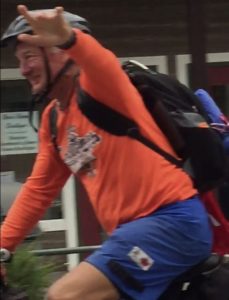
Of the 29 scratches (non-finishers) in the race, most were for human failings, ie: tendons/hamstrings/chafing etc. Mechanicals played their part, but most racers had put many, many miles on their steeds and knew what to expect of them. I did several ‘long’ rides on local gravel roads, ie: six to seven hours and did an overnight trip to Princeton and slept in the bush.
I should have “trained” harder, faster, and longer, but at seventy-three, there’s a limit to my strength and endurance, which I knew beforehand. All through the race, I kept looking for Lance Armstrong’s care packages, but alas, I found none.
I passed so many lovely lakes and streams that I desperately wanted to dip in and just stop and enjoy, but I did not succumb until the last evening at Koocanusa lake. What a joy to swim and wash after five days of hard riding! On reflection, maybe except for the awful Grey Creek Pass, the route would be nice to do in, say, two weeks, in a group–still riding hard, but stopping to smell the roses…often.
Who wants to do it? The Epic 1000
Nope, not again, for me…unless? I’ll be pleased to assist other Nicola Valley rider who wants to do it and I’ll continue to help Lennard with organizing a BBQ, home hosting, etc. The BC Epic 1000 is a free event, totally volunteer, which turns my cranks for sure. Any riders wanting to try bike-packing, I’d be glad to loan equipment and accompany you if desired. Go to Bikepacking.com for the best info. The kindred spirit of the racers was super, although, as stated above, I rarely saw another racer after day one, until the finish.
My thanks to my family and friends who sent texts of encouragement along the way, those who helped
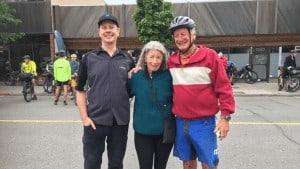
with the BBQ, home hosting, and to Mayor Menard who came out at 7 AM to start the race. Thanks to MMBA for renting the Park for the BBQ, which was appreciated by all the racers, as they got to meet each other–often for the first time.
Racers filled over fifty Merritt motel rooms the night before, and many will be back to enjoy the hospitality they experienced as well as the mountain biking on our great trails. A win for all.
Ride On!
Guest Blog post (and ride) by Darch Oborne
Executive Director of Merritt Mountain Bike Association
Thanks, Darch! Epic effort!
For more on Darch, and his contributions to our biking experiences in the Nicola Valley, click here.
And for those of you who would like to get on board this sport…
From the site Bikepacking: Simply put, bikepacking is the synthesis of mountain biking and minimalist camping. It evokes the freedom of multi-day backcountry hiking, but with the range and thrill of riding a mountain bike. It’s about exploring places less traveled, both near and far, via singletrack trails, gravel, and abandoned dirt roads, carrying only essential gear. Ride, eat, sleep, repeat, enjoy!
Comments
There are no reviews yet. Be the first one to write one.



